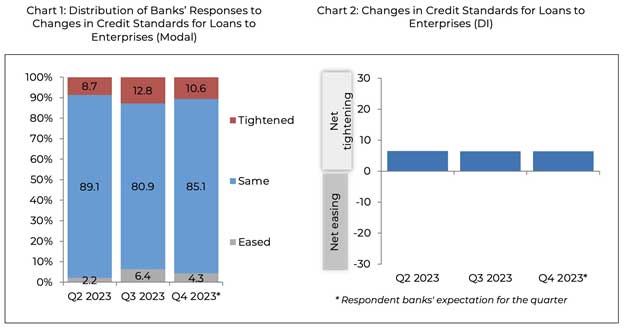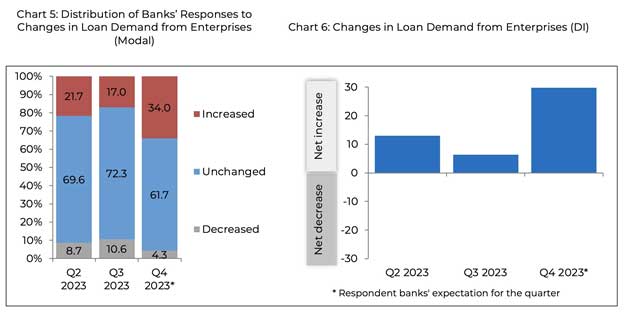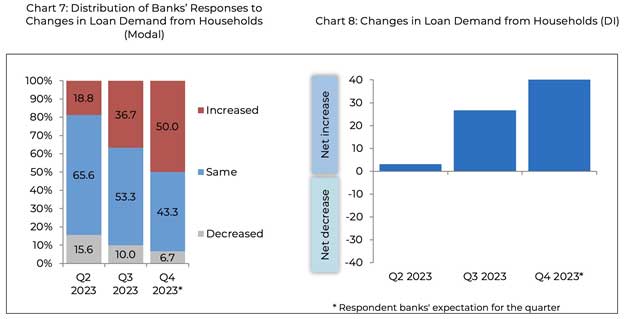Meanwhile, the diffusion index (DI) method[3],[4] indicated mixed results pointing to a net tightening of loan standards to businesses and a net unchanged lending standards for households.
Lending Standards for Loans to Enterprises
Using the modal approach, Q3 2023 results showed most of the surveyed banks (80.9 percent) maintained credit standards for businesses.
However, the DI approach indicated a net tightening of overall credit standards[5] across all borrower firm sizes driven by key factors such as lower risk tolerance; deterioration in the profitability of banks’ portfolios; and decline in the quality of borrowers’ profiles.
For Q4 2023, the modal approach reflected respondents’ anticipations of generally maintained credit standards for firms.
Meanwhile the DI method indicated surveyed banks’ outlook of net tightening of lending standards for the next quarter amid expectations of a deterioration in borrowers’ profiles and decline in the profitability of banks’ portfolios along with banks’ reduced tolerance for risk.

Commercial Real Estate Loans. Q3 2023 SLOS results showed that a majority of the respondent banks (84.4 percent) pointed to broadly steady lending standards for commercial real estate loans (CRELs).
Meanwhile, DI-based results indicated a net tightening of credit standards for CRELs during the quarter largely due to a decrease in risk tolerance; deterioration of borrowers’ profiles; and less favorable economic outlook. Over the following quarter, a higher proportion of banks expect to retain their loan standards for CRELS based on the modal approach, while the DI method showed a net tightening of credit standards for CRELs.
Lending Standards for Loans to Households
In Q3 2023, most respondent banks (68.8 percent) maintained their credit standards for loans to households.
The DI approach likewise pointed to a net unchanged credit standards for household loans[6] which was attributed by banks to steady economic outlook; sustained profitability of banks’ portfolios; unchanged risk tolerance; and steady profile of borrowers.
Over the following quarter, the modal approach indicated a larger proportion of respondent banks anticipating generally unchanged credit standards for household loans.
Meanwhile, the DI approach showed bank respondents’ expectations of a net easing in household credit standards in Q4 2023 mainly due to improvement in the profitability of banks’ portfolios and borrowers’ profiles along with banks’ higher tolerance for risk.

Housing Loans. Q3 2023 SLOS results indicated that a higher number of bank respondents (69.0 percent) maintained credit standards for housing loans.
On the other hand, the DI approach revealed a net easing of credit standards for housing loans which was attributed by banks mainly with less uncertain economic outlook along with improvement in profitability of banks’ portfolios and borrowers’ profiles.
While most respondent banks expect to maintain credit standards for housing loans in Q4 2023, the DI method shows a net easing of housing loan standards for the following quarter.
Loan Demand from Enterprises
A large majority of respondent banks (72.3 percent) indicated steady overall loan demand from firms in Q3 2023 based on the modal approach.
Meanwhile, the DI method continued to show a net increase in credit demand from across all firm classifications, due to customers’ improved economic prospects as well as increased inventory and accounts receivable financing needs.[7]
Over the next quarter, a higher number of bank participants anticipate generally unchanged credit demand from enterprises.
On one hand, DI results showed that surveyed banks expect a net increase in overall loan demand from firms in Q4 2023 due to higher inventory and accounts receivables financing requirements along with customers’ more optimistic economic outlook.

Commercial Real Estate Loans. Loan demand for CRELs is broadly steady in Q3 2023 and Q4 2023 based on the modal approach. Meanwhile, the DI method indicated a net increase in demand for CRELs in Q3 2023 as well as for Q4 2023 due to increased customer inventory and accounts receivable financing needs, a decline in customers’ internally-generated funds, improvement in customers’ economic outlook, among others.
Loan Demand from Households
More than half (53.3 percent) of the respondent banks reported generally unchanged household loan demand while about a third (36.7 percent) of respondents indicated increased demand for credit from households in Q3 2023 based on the modal approach.
DI-based results indicated a net rise in household loan demand across all key categories such as housing, credit card, auto, and personal/salary loans mainly due to higher household consumption and housing investment including banks’ more attractive financing terms.
For Q4 2023, respondent banks anticipate an increase in loan demand from households based on both the modal and DI methods driven by expectations of higher household consumption and housing investment, limited availability of other sources of funds and banks’ more attractive financing terms. [8]

Housing Loans. Respondent banks observed a generally unchanged demand for housing loans in Q3 2023 and anticipate a similar scenario in Q4 2023. However, DI results revealed a net rise in residential real estate loan demand for both the current and next quarter due to increasing household consumption and housing investment.
[1] The SLOS consists of questions on loan officers’ perceptions relating to the overall credit standards of their respective banks, as well as to factors affecting the supply of and demand for loans to both enterprises and households. The analysis of the results of the SLOS focuses on the quarter-on-quarter changes in the perception of respondent banks. The responses for the Q3 2023 SLOS were gathered between 4 September – 13 October 2023 from 48 banks out of the total 62 bank participants. The response rate of 77.4 percent is similar to the percentage of respondents in the previous quarter.
[2] In the modal approach, the results of the survey are analyzed by looking at the option with the highest share of responses. The three options for the modal approach are either 1) tightening, 2) easing, or 3) unchanged credit standards for loans to enterprises and for loans to households.
[3] In the DI approach, a positive DI for credit standards indicates that the proportion of respondent banks that have tightened their credit standards exceeds those that eased (“net tightening”), whereas a negative DI for credit standards indicates that more respondent banks have eased their credit standards compared to those that tightened (“net easing”). Meanwhile, an unchanged credit standards in the DI approach indicates that the proportion of the respondent banks that have tightened their credit standards is equal to those that eased their credit standards.
[4] During the Q1 2010 to Q4 2012 survey rounds, the BSP used the DI approach in the analysis of survey results. Beginning in Q1 2013, the BSP used both the modal DI approaches in assessing the results of the survey.
[5] The net tightening of credit standards for business loans in Q3 2023 is reflected in the reduced size of credit lines, stricter collateral requirements and loan covenants, and more use of interest rate floors.
[6] In particular, the DI approach reflected a net easing of loan standards for residential real estate, credit card, and personal/salary loans while a net tightening of lending standards was reflected for auto loans.
[7] The BSP Business Expectations Survey (BES) indicated that business confidence weakened in Q3 2023 but reported more optimistic expectations in the next 12 months. Firms’ more favorable outlook for the next 12 months was attributed primarily to their anticipation of: (a) brisker demand for goods and services across all sectors, (b) improved business climate amid a fully reopened economy, (c) further expansion and new business opportunities, (d) additional clients and projects, and (e) easing inflation.
[8] Based on the BSP Consumer Expectations Survey (CES), consumer sentiment for Q3 2023 improved marginally due to (a) more available jobs and permanent employment, (b) higher income from wages/salaries, remittances, and other sources, and (c) additional working family members. Meanwhile, the consumer sentiment for the next 12 months was less optimistic due to concerns over the: (a) faster increase in the prices of goods and higher household expenses, (b) fewer available jobs, (c) lower income, and (d) the effectiveness of government policies and programs on financial aid, inflation management, and economic growth.





















